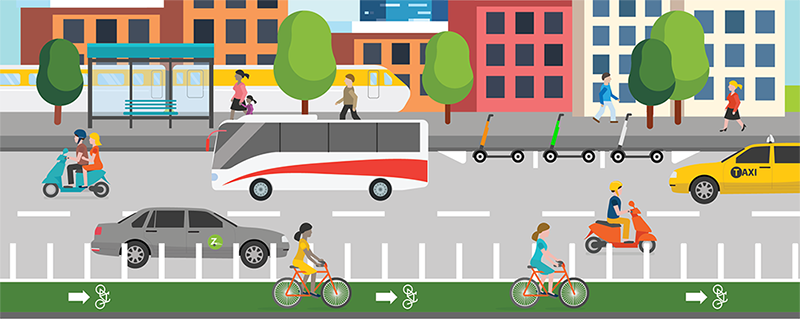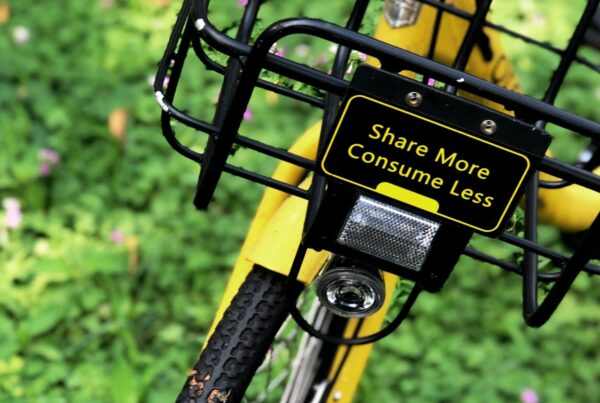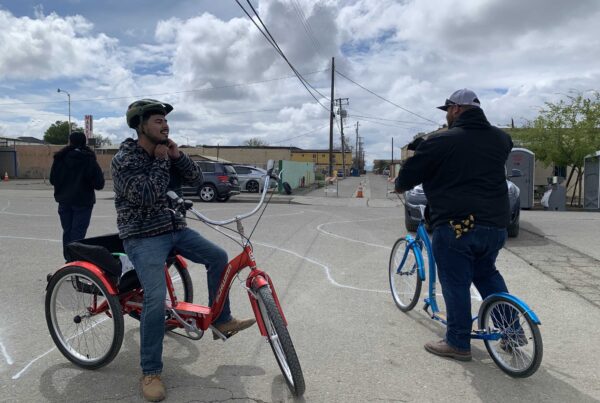Welcome to the Shared-Use Mobility Center’s weekly guide to the most impactful news, thought-provoking articles and innovative technologies that are shaping our transportation future. We believe in sharing information, just like sharing cars, bikes, and scooters, so if there’s anything additional you’d like to see, just drop us a line.
SUMC News and Announcements
Guiding Principles and Policy Priorities
As the year ends and we look to a more promising 2021, we believe it’s a good time to share our guiding principles and transportation priorities for the first 100 days of the Biden Administration. We are on the cusp of so much and looking forward to working with all of you to “Build Back Better.”
Make Mobility Available for All. Everyone is entitled to multimodal access to jobs, core services, and destinations that contribute to a good quality of life. Low-income, historically marginalized, and essential workers face greater barriers that must be overcome.
Empower Communities. Communities must have a voice in expressing their needs and in planning and envisioning transportation opportunities that strengthen communities.
Focus on Racial Injustice and Marginalized Communities. Transportation has divided communities in the past and we emphasize mobility opportunities and investments to right past wrongs.
Create Jobs that Boost Local Economies. Maximize good-paying jobs and opportunities in order to create innovative, decarbonized, multimodal transportation infrastructure, manufacturing, and expanded research and development.
Extend Safety Concerns Beyond the Occupants of Vehicles. Mobility must be safe for all travelers, with particular attention to pedestrians and those using bikes and scooters.
Mitigate Climate Change. Transportation must be decarbonized through an “all of the above” approach. Electrification is not enough. Attention must be paid to shared use, infrastructure design, and land use.
Establish Partnerships that Further the Public Interest. The public sector must set rules that support the public interest to ensure affordability, justice, and sustainability in all transportation programs, whether or not the project is led by private sector interests.
Use Public Investment to Create Mobility Options. Public investment must support shared assets, including sidewalks, micromobility infrastructure, and roadways by investing in transit and new modes that benefit all communities.
Optimize Freight and Delivery to Support Broad Goals. Federal policy must provide for the efficient flow of goods and services to enhance economic activity while supporting environmental justice, community-centered land use, and decarbonization.
Key Transportation Priorities for the First 100 Days of the Biden Administration
First Shared-Use Mobility Center Booklist
Ten standout picks as read by SUMC staff in 2020
- DIY City: The Collective Power of Small Actions, Hank Dittmar (Island Press, 2020)
- Saving America’s Cities: Ed Logue and the Struggle to Renew Urban America in the Suburban Age, Lizabeth Cohen (Farrar, Straus and Giroux, 2019)
- Cyclogeography: Journeys of a London Bicycle Courier, Jon Day (Notting Hill, 2016)
- The Color of Law: A Forgotten History of How Our Government Segregated America, Richard Rothstein (Liverlight, 2017)
- No One at the Wheel. Driverless Cars and the Road of the Future, Samuel Schwartz (PublicAffairs Books, 2018)
- City of Dreams: Dodger Stadium and the Birth of Modern Los Angeles, Jerald Podair (Princeton, 2017)
- Railtown: The Fight for the Los Angeles Metro Rail and the Future of the City, Ethan N. Elkind (UCPress, 2014)
- Order without Design: How Markets Shape Cities, Alain Bertaud (MIT Press, 2018)
- The Geography of Bliss, Eric Weiner (Twelve, 2009)
- The Known World, Edward P. Jones (Amistad, 2003)
Mobility Justice
The Transportation Equity Caucus, a coalition of leading organizations that aim to bring equitable opportunity and mobility access to the masses, hosted a webinar about the history of police enforcement in transportation featuring Equiticity President and CEO Oboi Reed and DC’s Deputy Director of Community Planning and Design (and former SUMC Board Member) Anita Cozart. Read about the moderated discussion on Streetsblog Chicago.
“Community” is a slippery geographic and social notion. If it’s a physical geography, how is it bounded? If it’s a social construct, what is its membership?” Learn about the importance of place governance and how making it equitable from the start can spur alliances and thought leadership.
Elderly pedestrians are the most vulnerable to traffic deaths while driving. (It’s been increasing since 2009!) Enter the National Highway Traffic Safety Administration’s latest Older Driver Safety Awareness Week campaign, which despite its caring title, does nothing to address the car dependence that forces seniors to drive in the first place.
PODCAST: Brookings scholars Annelies Goger and Martha Ross discuss their proposals for racial justice and worker mobility. Listen now on the Brookings Cafeteria.
Ridehailing/Carsharing/Carpooling
Lyft and Uber have announced healthcare program stipends and new fare structures that will supposedly guarantee that minimum wages are coming to California ridehail drivers, following the Proposition 22 win that gig economy companies netted just last month.
On the pandemic front, both ridehail giants have also asked US government officials if they can be included in the first set of vaccine shipments because of the services drivers provide as “a lifeline to their communities” through trips for healthcare workers and food delivery for local restaurants.
P2P carsharing platform Turo will be returning to New York in January 2021 (for members of its commercial host program) after a seven year hiatus due to insurance violations in the state.
Salem, MA gets a new on-demand ride service, called Salem Skipper, courtesy of a partnership with ridehail company Via that will use four vehicles to cater to the public, with wheelchair accessibility included.
Bikesharing and Micromobility
Check out this feature about the differences between state, local, and regional micromobility policies in specific parts of the US, Europe, and in China on CleanTechnica. (Then learn more with our Micromobility Policy Atlas on the Learning Center)
There’s a gender gap in the way micromobility options like biking and scooters are used, but an even more apparent gender bias when looking at how these systems, and the infrastructure around them, are built, according to research from mobility management company Invers.
LA has seen a record low in cycling collisions on city streets according to LAPD data showing 18 bike-vehicle collisions in September (compared to the high 185 incidents in the same month last year), the lowest ever recorded for the metro.
The BBC unravels the necessity and historical value of The Great American Rail-Trail project that aims to connect the East and West Coast in the US through 3,700 miles of connected active transportation pathways and how it can connect regional cultures and communities.
Transit
Illinois Representative Jesús “Chuy” García (IL-04), along with Representatives Pressley (MA-07), Jeffries (NY-08), and 30 Members of Congress, released a resolution last week that would call on the US government to boost transit’s funding allocation to meet an even 50-50 split with highway expenditure and dedicate public transportation initiatives to bring racial and economic justice to those who rely on transit the most.
President-elect Joe Biden is set to nominate former South Bend Mayor and presidential candidate Pete Buttigieg to head the US Department of Transportation, making him one of the youngest cabinet members in history and the first openly gay member appointed to a permanent role. Congratulations Mayor Pete!
The Federal Transit Administration has awarded $6.2 million to build out transit-oriented development in the country to spur public transit use and “improve economic development and multimodal connectivity”.
LA County’s Metro Micro on-demand microtransit program—operated by mobility company RideCo—will start serving the South LA and the LAX/Inglewood areas with an additional seven more zones being added to the service in 2021.
Technology
Autonomous tech startup Zoox, which was acquired by Amazon earlier this year, has unveiled its electric and driverless robotaxi that is outfitted with a plethora of sensors, cameras, and customizable configurations while featuring no steering wheel.
Zero driver seems to be the trend with AVs, and the GM-backed Cruise is now testing self-driving cars on San Francisco streets that feature no back up driver. You can check out how the autonomous Chevy Cruises handled the feat on Mashable.
Shiny, tech-filled, robot mobility services catch the eyes of the public but how are first responders trained to approach these vehicles, and its riders, in an emergency situation? Fleet Forward covers a training session between Florida-based autonomous vehicle company Beep and first responders, fire fighters, and law enforcement in the state.
Mobility offering Lime and mapping provider what3words have teamed up to help the micromobility giant pinpoint exact locations of its dockless vehicles to find any that have been mis-parked or abandoned by users.
Sustainability
Technology can be shoehorned into today’s transportation problems as a temporary fix but the fundamental inefficiency of space will always remain. World Economic Forum looks at the “next frontier” of fixing urban mobility challenges (though not a completely new issue): reducing the vast amounts of unused parking in our cities.
Bogotá’s Avenida Séptima has been a roadway since the 16th Century. While there have been unsuccessful attempts to modernize the busy corridor and turn it into a green-and-clean mobility avenue as residents felt left out, Mayor Claudia López and city planners want to change that, one community meeting at a time.
A “freeway” isn’t really free when the onus of funding is hidden from drivers, and the use of roadways doesn’t represent its true cost whether it is during the rush-hour crunch or middle of the night. City Observatory (rightfully) believes this model consequently pays people to drive.
Learn how the ambitious ART in the Right of Way mural project wants to bring traffic-calming solutions and build better pedestrian safety along many major streets with a creative network of artists and tactical urbanism enthusiasts in Tampa on Next City.
Requests for Proposals, Inquiries, and Information
RFP: Microtransit Technology Services
Virginia Department of Rail & Public Transportation
Gloucester County and Town of Wise, VA
Deadline: December 31, 2020
RFSOQ: Las Vegas Medical District Automated Circulator and Connected Pedestrian Safety Program
Regional Transportation Commission of Southern Nevada (RTC)
Las Vegas, NV
Deadline: January 5, 2021
Notice of Intent: Accelerating Clean Transportation Now Program
Massachusetts Clean Energy Center (MassCEC)
Boston, MA
RFP Release: January 8, 2021
Open Call: Climate Smart Cities Challenge
Nesta
London, GB
Deadline: January 22, 2021
Did someone forward this to you? Sign up for our newsletter here.



